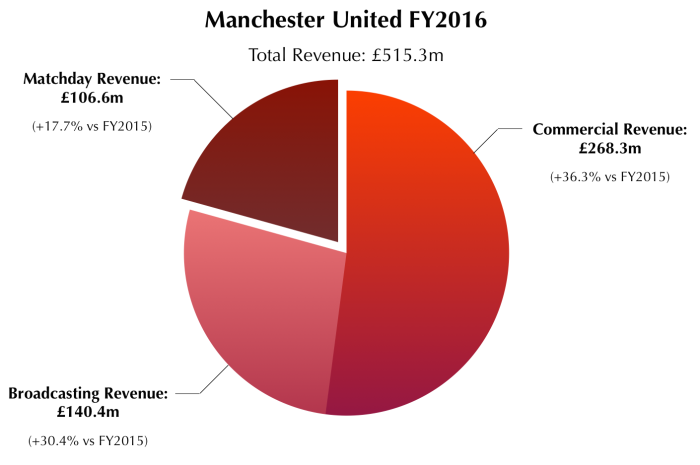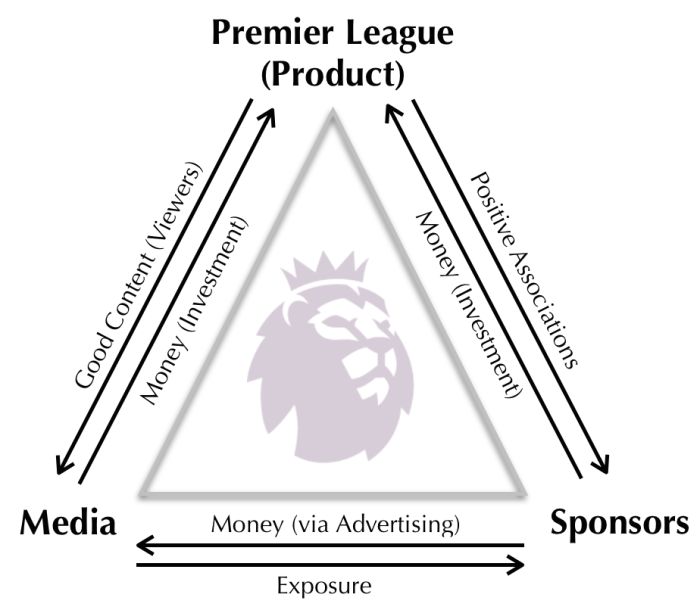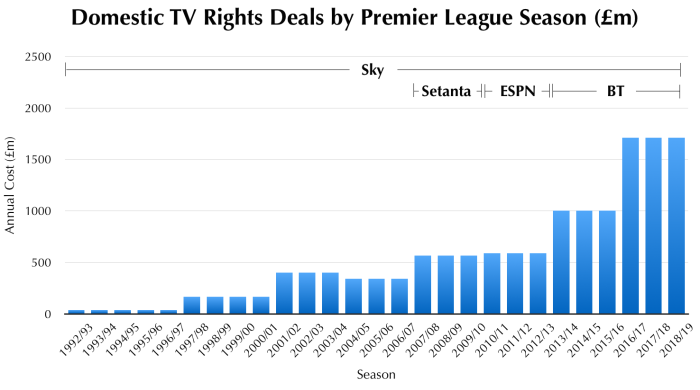The Premier League, the football division of England’s top 20 clubs, is widely recognised as the best domestic league in the world for its entertainment quality and competitive nature. And the world can’t get enough of it. Arguably the most successful British export industry of the last 20 years, the Premier League can no longer be considered only in football terms but also a juggernaut of business that contributed £3.4bn to UK GDP in 2013/14.
But how has a sporting division become so valuable? How has the league and clubs within it become such valuable ‘brands’ – a phrase that makes most football fans cringe – and been marketed so successfully?
A quick look at the 2016 revenue breakdown of Manchester United, the Premier League’s leading club in terms of business performance, shows how the revenue streams have changed proportionally over the Premier League era. Twenty years ago, matchday was every club’s payday as the match-going supporter turned out to pay to watch their local team and hopefully buy a pie and a pint at half time. Barring the launch of a new kit every two or three years and their share of a small pot of TV money, that was pretty much these clubs’ means of balancing the books. Fast forward to today and that matchday revenue could almost be swallowed whole by Manchester United’s commercial and broadcasting income: (And they’re still growing fast…)

But why? As a ‘product’ at the most basic level, the Premier League hasn’t changed from what preceded its infancy in 1992 – it’s the same game of football with the same rules and is certainly no different to the other domestic top divisions across Europe and the world. But what’s changed is the way it’s packaged as entertainment.
Context:
To understand this, we need to understand where English football was at in the 1980s – and it couldn’t have dropped much lower. Hooliganism was rife, as rising unemployment and political disillusionment seemingly manifesting itself in football grounds, which saw English clubs booted out of European competitions for five years. The damning indictment on the state of football from the Taylor Report, commissioned in the wake of the Hillsborough disaster where 96 football fans were crushed to death at the 1989 FA Cup Semi-Final, led to a commitment from the government to help football lift itself out of the gutter. Added to this, the country’s top clubs were lobbying to shift power from the one-club one-vote policy, and the national pride from England’s heroic performance at the Italia ’90 World Cup was an insight into the positive light our national game could be shone upon.
Whilst perhaps a very simplistic portrayal of events, I think it’s important to emphasise the key intangible asset that’s missing from every successful businesses’ balance sheet – luck. The stunning rise of the Premier League to what it is today simply couldn’t have happened without the convergence of these favourable happenings. All that was now missing was the vision…
The Future of Football:
The Premier League as we know it today was based upon the marketing template of American sports like American Football. The idea being to portray the product as entertainment that will garner interest from sponsors who would now want to associate themselves with football, generate a sizeable television audience and gain traction in the media. This then creates a platform for rolling success because more revenue into the game that can be invested into attracting the best players in the world to the Premier League that enhances the product for further growth, keep it out of reach from the competition that is other domestic divisions that are vying for these top players.
The Premier League, sponsors and media formed the three parts of the pyramid that formed the beginnings of this rolling success, with each stakeholder offering something to and wanting something from one another.

The media craves good content, not only broadcasting an exciting football match but also a newspaper getting an interview with star footballers, because it sells copies. Sponsors want exposure and will happily pay for the privilege, so play their part in bankrolling the ever-growing investment into the Premier League.
The role of Sky Sports can never be underestimated in the boom of the Premier League. Two years before the new league’s infancy, Sky was losing £2m a week but quite literally bought into the vision of football as it is today and gambled its own future on the success of the Premier League – agreeing a five-year deal for broadcasting rights.
And Sky helped bring glamour to the football product early on, with televised match times shifted to suit the TV audience and a new concept of Monday Night Football, which kicked off with a pre-match show of fireworks and dancing cheerleaders. Furthermore, Sky has always self-promoted the Premier League through its own dedicated Sky Sports News channel that’s made a drama out of the league with constant news, speculation and transfer rumours generating conversation and increased interest in the game. Transfer ‘deadline day’ has become an obsession for football fans up-and-down the country (and now internationally), to the point that supporters are left deflated if their club doesn’t bring in a new player at the eleventh-hour.
So was it a worthy investment from Sky? Given the exponential rise of broadcasting rights at each renewal and Sky’s cemented status as a media juggernaut in the UK, the proof is in the pudding. Whilst its hold on the Premier League has been challenged unsuccessfully by the likes of Setanta Sports and ESPN, with BT Sport now giving it a go, the first mover’s managed keep a firm hold. And through all this, the Premier League has been the main benefactor through the extra revenue at each renewal of rights:

What’s Next?
I would think there’s most certainly still future growth in the Premier League, at least internationally. On a broadcasting front, there’s been a consistent lag on TV deal revenues from the overseas markets compared with the domestic agreements, which will catch-up as global demand rises. More than a fifth of the world’s population already watches the English Premier League and even the Chinese president believes football is the next frontier for his country. It’s hard to disagree when virtually every Premier League team will be touring one of the four corners of the planet this summer to grow its own ‘brand’ – even if that’s at the expense of ideal conditions for pre-season training, which in theory should be the number one priority.
Furthermore, I believe the ever-expanding reach across the planet is significant in terms of club ownership too. Premier League clubs engage with one-and-a-half billion people around the world for 90 minutes every week, so they’re the perfect marketing tool for the most wealthy businessmen – particularly when you consider that buying a football club is only a fraction of the cost that any other large corporate entity would be.
Only time will tell if this has a positive impact on the individual clubs at the centre of a takeover…
Final thoughts:
As a huge football fan and marketer myself, the growth of the Premier League is one of the most fascinating topics for me – and I benefit from seeing both perspectives on how English football has changed in the last couple of decades.
Football is now most-certainly a business and not just a sport, and that pains many a traditional supporter that feels like they’re not put first when it comes to decisions such as ticket prices and cost of merchandising.
The passion demonstrated by fans has always been one of the most unique and alluring characteristics of the English game so it is in the interest of all stakeholders to protect it – as it’s a key part of the product that the Premier League promotes. This has become a genuine concern for the Premier League over the last few years, with more and more working-class supporters being priced out of the game as its become more globalised. Already, a £30 cap has been put onto away fan tickets in recognition of the additional travel expenses they incur, but more will most certainly need to be done as the cost of football continues to rise.



















Interesting stuff to read. Keep it up.